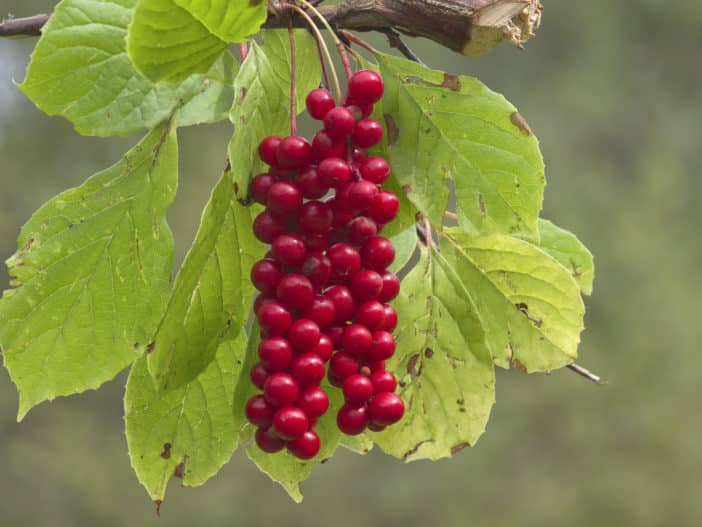Schisandra

Schisandra (Chinese: Wu Wei Zi) is a plant species of the star anise family and originates from China. In the meantime, however, it can also be found in Korea and Japan. Schisandra was used as early as the late Han Dynasty (206 B.C. to 220 A.D.).
The deciduous climbing plant can reach growth heights of up to eight meters and forms many pink to red fruits that grow in dense clusters and ripen between July and September. They are also called “berries of the five tastes” because they combine all five classic tastes, i.e. sweet, sour, spicy, bitter and salty. However, in the textbooks of Traditional Chinese Medicine, the berries are officially classified as sour. Basically, both the ripe dried berries (Schisandrae fructus) and the seeds and dried leaves (Folia Schisandrae) can be used. Notable side effects are not known so far, but Chinese grape berry should not be taken in case of internal heat. In isolated cases, it may cause heartburn when used internally.
Schisandra and its use in Traditional Chinese Medicine
Schisandra is a well-established medicinal plant in China for a wide variety of health ailments. Its main uses include liver weakness, signs of aging, and general debility. However, Schisandra also helps with common ailments such as diabetes, fatigue, burnout syndrome and anxiety. Other indications include colds, coughs and asthma, heart palpitations, exhaustion, insomnia and eczema, as well as poor concentration, stress, forgetfulness, fatigue, skin inflammation/rash, diarrhea and libido weakness. Studies by vascular specialist Andrew Chevallier (Middlesex University) showed that the ingredients act like a quick cleanse for the vascular system. The berry grape is also said to help against cancer. However, conclusive studies are still missing for it.
The healing effect is described among other things as blood-purifying, regenerating, strengthening and antispasmodic. In addition, the medicinal plant is said to have both aphrodisiac and balancing properties.
Schisandra is rich in essential oil. Also contained are lignans (phytohormones), minerals and vitamins, with vitamin C being particularly high. The leaves and seeds also contain the ingredient schisandrin. Schisandra is mostly used as a tea made from dried berries. However, consumption of the dried berries is also common. Since neither berries nor leaves are toxic, Schisandra can be safely chewed. However, ingestion or consumption should be discontinued for a while after six weeks to avoid a habituation effect.
The Chinese magnolia-vine in cosmetics
Schisandra is also becoming increasingly important in cosmetics. For example, the extract from the Chinese berry grape is able to help aged skin regain its firmness. In this context, the focus is primarily on stimulating the synthesis of collagen XVII and ladinin-1. These are two extremely important molecules of the dermo-epidermal junction. They are responsible for tension between the dermis and epidermis and for cohesion. In vitro tests have shown that Schisandra or its extract increases ladinin-1 synthesis by 3.5-fold and collagen XVII synthesis by as much as 6.0-fold.
In studies, the increase in the expression of the genes responsible for the production of collagen XVII and ladinin-1 could be proven by investigations on gene chips. Thus, it is clear that Schisandra can effectively strengthen age-related reduced dermal-epidermal dynamic cohesion. This is also proven by an in vivo study involving 17 women who had already reached the age of 60. A cream containing 0.3 percent Schisandra clearly increased skin elasticity and skin firmness by 28 percent after 56 days, with the cream being applied twice daily. Schisandra is also very suitable for skin soothing and special care for sensitive, stressed skin.
It should also be mentioned that the oil-soluble active ingredients are 100 percent organic. The Chinese berry grape is also free of preservatives.
Fact Sheet Schisandra
Alternative names: magnolia-vine, Chinese magnolia-vine, schisandra chinensis
Scientific name: Schisandra
INCI: Schizandra Chinensis Fruit Extract
German name of the extract: Schizandra Chinensis Berry Extract
CAS number: 223748-53-6
Ingredients: Lignans (phytohormones): Schizandrin, gomisin, essential oil, deoxyschizandrin, minerals, vitamins
We like to work with raw materials containing Schizandra Chinensis:
| Trade Name | Company Name | INCI | Comment |
|---|---|---|---|
| SCHISANDRA BERRY EXTRACT 5:1 | Bio-Botanica, Inc. | Propylene Glycol, Schisandra Chinensis Fruit Extract | |
| Schisandra Berry Extract - Phytobasic | Bio-Botanica, Inc. | Butylene Glycol, Schisandra Chinensis Fruit Extract | |
| Schisandra Fruit CO2-to extract, Variety Chinensis - 164.003 | Flavex Naturextrakte GmbH | Schisandra Chinensis Fruit Extract | |
| SG-Omija Extract | CoSeedBioPharm Co., Ltd. | Butylene Glycol, Schisandra Chinensis Fruit Extract | |
| Sqisandryl LS 9905 | BASF | Schisandra Chinensis Fruit Extract | |
| URBALYS | Greentech | Propanediol, Aqua, Schisandra Chinensis Fruit Extract |
The Chinese magnolia-vine: a natural and very effective active ingredient for anti-aging products
In traditional Chinese medicine, this ancient medicinal plant has been firmly established for more than 2000 years, and for some time now it has also been making itself indispensable in sophisticated cosmetics. It plays a particularly important role in anti-wrinkle products. As described above, the cosmetic effect in the anti-aging area has already been proven by extensive studies and tests. In addition, the extract reduces oxidative stress and soothes the skin, so that even sensitive skin types benefit from it. For a natural plus in resilience and youthful radiance, Schizandra Chinensis Fruit Extract is therefore an optimal choice. Cosmacon will be happy to develop high-quality formulations for you that meet your needs.
Sources:
Antioxidant Effects of Schisandra chinensis Fruits and Their Active Constituents.; Antioxidants (Basel). 2021 Apr 18;10(4):620.
Current knowledge of Schisandra chinensis (Turcz.) Baill. (Chinese magnolia vine) as a medicinal plant species: a review on the bioactive components, pharmacological properties, analytical and biotechnological studies.; Phytochem Rev. 2017;16(2):195-218.
Evaluation of the Antioxidant, Cytoprotective and Antityrosinase Effects of Schisandra chinensis Extracts and Their Applicability in Skin Care Product.; Molecules. 2022 Dec 14;27(24):8877.
A Study on the Fabrication of an Effective Natural Substance Based on Schisandra chinensis Extracted Fermentation.; Clin Cosmet Investig Dermatol. 2021 Nov 2;14:1603-1612.